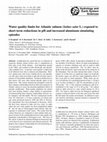Papers by Bjørn Olav Rosseland
Årsliste 2000MOLAR (Measuring and modelling the dynamic response of remote mountain lake ecosyste... more Årsliste 2000MOLAR (Measuring and modelling the dynamic response of remote mountain lake ecosystems to environmental change: A programme of Mountain Lake Research - MOLAR) is an extensive European co-operative research project with 23 partners. It is funded within the European Commission Framework Programme IV: Environment and Climate with assistance from INCO. It is co-ordinated by the Environmental Change Research Centre (ECRC) at University College London (UCL) and the Norwegian Institute for Water Research (NIVA). The project has four major strands also called Work Packages, and the final results from each of the Work Packages (WP) are reported here. Appendix A shows the publications from the total project activities, and Appendix B separate reports from all partners.Commission of the European Communities Natitional Research Council

Journal of Fish Biology, 2017
This study focuses on plerocercoids of the cestode Diphyllobothrium ditremum in brown trout Salmo... more This study focuses on plerocercoids of the cestode Diphyllobothrium ditremum in brown trout Salmo trutta from the subalpine lake Øvre Heimdalsvatn in south-central Norway. Salmo trutta was the only fish species in this lake until European minnow Phoxinus phoxinus was registered in 1969. The P. phoxinus population increased substantially in the following years. In contrast with the 1969-1972 period, when plerocercoids of D. ditremum were practically absent in S. trutta, there was a high prevalence and intensity of infection in the 2013 S. trutta samples. Because the life cycle of D. ditremum involves two larval stages, in copepods and salmonids and mature worms in piscivorous birds, such as mergansers and loons, a change in feeding ecology of S. trutta or changes in population densities of copepods, fish or birds might have influenced the infection pattern. No relationships between D. ditremum infection and muscle-tissue 15 N signature or Hg concentration were found, indicating that infection is not a result of piscivory or cannibalism. Furthermore, consumption of copepods by S. trutta during summer and autumn was low. On the other hand, the number of piscivorous birds has increased, probably due to the presence of P. phoxinus as a new and numerous prey. An increased number of final D. ditremum hosts may have produced a higher output of cestode eggs, resulting in more infected copepods that in turn are consumed by S. trutta. Indirectly, P. phoxinus may therefore have caused the observed increased infection in S. trutta and thereby imposed further negative effects on S. trutta in high mountain areas.
The Rain-project started in 1984, with the purpose to study effects on and changes in water quali... more The Rain-project started in 1984, with the purpose to study effects on and changes in water quality, after excluding acid rain. Based on water chemistry, the runoff from the clean rain catchment has developed in a "positive" direction, responding to decreased input of SO4 and NOx. Toxicity of the runoff from the catchments at the RAIN-project, was tested with 5 strains of brown trout. The chemical composition of runoff water from the clean site has proved to be more toxin than water from the untreated, neighbouring site. The higher toxicity levels after excluding acid rain is assumed to be caused by reduced calcium concentrations in the runoff, while the pH and aluminium levels still were toxin. There proved to be significant difference in tolerance among the five strains tested.PowerGen PLC and National Power PLC and National Power (Join Environmental Program),U
Rapporten gir en sammenfatning av arbeidet med å produsere og ekstrahere toksin av algen Chrysoch... more Rapporten gir en sammenfatning av arbeidet med å produsere og ekstrahere toksin av algen Chrysochromulina polylepis, samt forsøk med å etablere metoder for påvisning av hemolytisk effekt og toksikologiske effekter på laks. Det gis også en oversikt over forskningsområder som det vil være aktuelt å videreføre

Journal of Environmental Radioactivity, Sep 1, 2013
Uranium (U) ore mining and processing were initiated in the former Soviet Republics of Tajikistan... more Uranium (U) ore mining and processing were initiated in the former Soviet Republics of Tajikistan after the Second World War as part of the USSR nuclear weapon programme. The U mine in Taboshar was opened in 1936, and mining took place from 1945 to 1965, while the Digmai tailings dump was exploited during 1963-1993. The mining, milling and extraction activities have resulted in large amounts of waste rock deposits and U tailing materials placed in the vicinity of inhabited areas. To assess the environmental impact of radionuclides and trace metals in the Taboshar and Digmai mining and tailing sites in Tajikistan, field expeditions were performed in 2006 and 2008. In addition to in situ gamma and radon dose rate measurements, sampling of water, fish, sediments, soils and vegetation including in situ fractionation of water were performed. The U concentrations in water from Taboshar Pit Lake (2.0 mg U/L) were higher than in waters collected in the Digmai area. The Pit Lake and the stream water from the tailing mountain were also characterised by elevated concentrations of As, Mo, Mn and Fe, exceeding the WHO recommended values for drinking water. Uranium, As, Mo and Ni were present as low molecular mass species in the waters, and are therefore considered mobile and potentially bioavailable. The (238)U concentrations in sediments and soils varied between the sites; with peak concentrations (6 kBq/kg dw) in sediments from the Pit Lake, while the soil concentrations were significantly lower (296-590 Bq/kg dw). In contrast, high levels of the radium isotopes ((226)Ra and (228)Ra) were found in the Digmai soil (17-32 kBq/kg dw). Based on sequential extraction results, both U and Pb were found to be quite mobile at the Pit Lake site, showing that these elements were associated with the pH sensitive and redox sensitive amorphous fractions. In tailings, U was found to be quite mobile, but here Pb was rather inert. The transfer of radionuclides and metals from sediments to waters was in general low. In the Pit Lake, U was quite mobile (Kd = 90 L/kg), followed by Ni (1.5 × 10(3) L/kg) and As (6 × 10(3) L/kg), Cu and Cd (1.5 × 10(4) L/kg), while Pb (3 × 10(5) L/kg) was rather inert. The transfer from soil to plant, TFs (kg/kg dw), was in general low, while the bioconcentration factor for water living Poaceae and for fish from water was relatively high (Pb 1.8 × 10(5) and Cd 1 × 10(4)). These legacy sites, containing enhanced levels of natural radioactive material (TENORM) as well as heavy metals, may represent a hazard having a potential radiological and chemical impact on man and the environment, and measures should be taken to reduce the environmental risk to man and biota.
26, Sep 1, 2011
Rapporten oppsummerer effektene av vegsalt og blandingen vegsalt og kobber (Cu) på tidlige utvikl... more Rapporten oppsummerer effektene av vegsalt og blandingen vegsalt og kobber (Cu) på tidlige utviklingsstadier hos Atlantisk laks (Salmo salar L.), fra befruktning til klekking og “swim-up”. Forsøket ble gjennomført ved Fiskelaboratoriet, UMB. Resultatene indikerte subletale (ikke dødelige) effekter under befruktning ved høye vegsaltkonsentrasjoner (≥5000 mg/L), mens senere livsstadier var mindre følsom. I tillegg ble det observert deformiteter som følge av eksponeringen med vegsalt og Cu i kombinasjon. Det synes derfor som om sensitiviteten øker hos laks i tidlige livsstadier når de eksponeres for vegsalt i kombinasjon med andre forurensninger i avrenningsvann fra veg

Hydrology and Earth System Sciences, Mar 5, 2008
Acidification has caused the loss or reduction of numerous Atlantic salmon (Salmo salar L.) popul... more Acidification has caused the loss or reduction of numerous Atlantic salmon (Salmo salar L.) populations on both sides of the North Atlantic. Acid deposition peaked in the 1980's and resulted in both chronically and episodically acidified rivers. At present, water quality is improving in all affected rivers due to reduced acid deposition. However, spring snow melt, heavy rainfall and sea salt episodes can still cause short term drops in pH and elevated concentrations of bioavailable aluminum. Technical malfunction in lime dozers will cause short termed episodic spates in the limed rivers. The current situation has prompted a need for dose-response relationships based on short term exposures of Atlantic salmon to assess the potential population effects of episodic acidification. Water quality guidelines for salmon have been lacking, despite a large number of experiments, all demonstrating dose-response relationships between water chemistry and fish health. We have summarized results from 347 short-term (<14 days) exposures of salmon parr and smolt performed between 1990 and 2003 in Norway. The experiments have been performed as bioassays, where fish have been exposed in tanks fed river water, in tanks where the river water quality has been manipulated (added H + and Al) and as Carlin-tagged smolt releases after preexposure to moderately acidic waters. The results from the various bioassays are compared to water quality limits proposed on basis of the relationship between water quality and population status/health in Norwegian rivers. The focus of this article is placed on chemical-biological interactions that can be drawn across experiments and exposure protocols. We propose dose-response relationships for acid neutralizing ca

Aquatic Toxicology, Feb 1, 2012
Silver nanoparticles (Ag-NP) are components in numerous commercial products and are discharged in... more Silver nanoparticles (Ag-NP) are components in numerous commercial products and are discharged into the environment in quantities that are largely unknown. In the present study, juvenile Atlantic salmon were exposed to 1, 20, and 100 g/L (48 h, static renewal) of a commercially available Ag-NP colloidal suspension in natural (soft) lake water. A solution of AgNO 3 containing 20 g/L Ag(I) ions was also included to discriminate the effect of NPs from that of ionic silver. Furthermore, the commercial Ag-NP suspension was compared to an in-house synthesised colloidal NP suspension prepared from AgNO 3 and NaBH 4 in citrate buffer. The size distribution of Ag in all exposure solutions was characterised by 0.22 m filtration and 10 kDa hollow fibre cross-flow ultrafiltration in combination with ICP-MS. All exposures were characterised by a relatively high proportion of Ag-NP in the colloidal size fraction 3-220 nm. For assessment of biological effects, acute toxicity, gill histopathology, blood plasma parameters (Na, Cl, glucose, haemoglobin), and gene expression of a selection of gill biomarkers were measured. Results showed that the gills accumulated Ag in all exposure groups apart from the fish exposed to 1 g/L Ag-NP. Accumulated Ag caused concentration-dependent response increases in general stress markers such as plasma glucose and gill gene expression of heat shock protein 70. Furthermore, induction of the metallothionein A gene indicated that Ag had been internalized in the gills, whereas a concentration-dependant inhibition of Na/K ATPase expression indicated impaired osmoregulation at as low as 20 g/L concentrations of Ag-NP. The commercial Ag-NP suspension caused acute gill lamellae necrosis at high concentrations (100 g/L), potentially giving rise to the substantial (73%) fish mortality at this concentration. The two different Ag-NP preparations gave comparable results for several endpoints measured, but differed in MT-A induction and mortality, thus emphasising the variation in effects that may arise from different Ag-NP preparations.

NATO Science for Peace and Security Series
ABSTRACT A Joint Norwegian Kazakh and Kyrgy project has been established related to the contamina... more ABSTRACT A Joint Norwegian Kazakh and Kyrgy project has been established related to the contamination associated with uranium mining and tailing in the former USSR republics. The aims of the project are to assess long term consequences from radioactive and trace metal contamination, in particular associated with uranium mining and tailing, at selected sites in Kazakhstan and Kyrgyzstan, to evaluate the needs for alternative countermeasures, and to strengthen the scientific competence as well as the national authorities with respect to infrastructure and legislation for radiation pro- tection. The present paper describes the first joint fieldwork, which took place in June 2006, at the uranium mining area at Kurday, Kazakhstan. Radon detectors were place indoor and outdoor. A series of samples were collected and in situ fractionation of radionuclides in lake, river and well water were collected. A broad analytical pro- gramme, including the analysis of radionuclides and metals, will be implemented in 2006/2007.

Årsliste 2003The effect of water hardness on the chronic toxicity of zinc to early life stages of... more Årsliste 2003The effect of water hardness on the chronic toxicity of zinc to early life stages of brown trout has been studied. Separate tests were carried out in four dilutin waters. Two of these were natural lake waters from Lake Maridalsvann (hardness 8.6 mg CaCO3/l and Lake Store Sandungen (hardness 6.7 mg CaCO3/l). High-hardness waters were prepared by adding calcium to these waters to achieve a hardness level of 100 mg CaCO3/l. Eggs of brown trout were fertilised in the test waters and exposed for approximately 120 days in flow-trough channels. Hatching success, time to hatching and length and weight of larvae at termination of the test were observed. Signifcant delay of haching was observed at 100 µg/l nominal, added concentrations of Zn in both lake waters. The NOECs were 56 and 61 µgZn/l respectively. With increase of water hardness to 100 mg CaCO3/l, the effects of Zn was reduced in Lake Store Sandungen (NOEC=250 µg/l) but not in Lake Maridalsvann (NOEC=57 µg/l). The effects on length and weight of larvae on test termination were generally less prononced.International Lead Zinc Research Organizatio

Water, Air, and Soil Pollution, 1986
Although the decline in fish populations due to acidic water in Norway started as early as in the... more Although the decline in fish populations due to acidic water in Norway started as early as in the 1920's the most rapid losses appeared during the 1960-70's. Until 1978, the populations of Atlantic salmon had disappeared from the southernmost part of Norway, and in these areas, more than half of the brown trout populations had been lost. Today, in spite of no increase in acid depositions, the fishery problems seems to continue at the same speed. Data based on interviews of the local fish authority shows that lakes still holding a fish population in the late 70's, have experienced a 30% loss of brown trout populations and a 12% loss of perch in the period1978-1983. This trend have been confirmed bytestfishing in lake systems having long data series. Salmon rivers on the western coast of Norway have experienced several episodes of fish kills due to rapid changes in water quality. These fish kills have mainly affected smolts of Atlantic salmon. Spawning migrating salmon on entering their acidified home river have also been affected. In Sweden, several salmon populations along the western coast have been lost due to acidification with no positive trends so far in the 1980's. Areas in central Sweden and in some high mountain areas are still experiencing a continuous and increasing acidification with detrimental effects on invertebrates and fish. In Finland, an increase in acidic deposition during the last decades have occurred, leading to acidification in the most sensitive freshwater systems. Although some acidified freshwater lakes are reported to have lost their fish stocks, few data on fish population effects are availabl~

Water, Air, and Soil Pollution, 1986
Physiological stress, measured as changes in plasma chloride, and mortality were measured on diff... more Physiological stress, measured as changes in plasma chloride, and mortality were measured on different year-classes of landlocked and migratory Atlantic salmon, two strains of brown trout, and brook trout, in a flow-through system with acidic Al-rich soft water. The oldest year-classes of salmon were smolts. Water from Lake Byglandsfjord (pH = 5.9), was enriched with inorganic AI (as AICI3) ~nd H2SO 4 to pH = 5.1, total AI = 225 ug L-I, and labile AI = 135 ug L-~. As a reference, lake water was limed by means of a shellsan~ filter to pH = 6.2, increasing Ca-concentration from 1.0 to 1.5 mg L-~. During the 83 hr experiment, neither mortality nor physiological stress occurred in any species or year-class in the limed water. In the acid water, no mortality occurred on any stage of brown trout or brook trout. Among the migratory and landlocked salmon, however, 5% of the alevins died after 49 and 70 hr, respectively. All smolts of both the landlocked and the migratory salmon died after 83 and 35 hr, respectively, the co~responding loss rate of plasma chloride was-0.76 and-1.26 meq CI hr-~. Brook trout, however, increased plasma ion concentration during the experimental period, and hence showed no stress.
Water, Air, and Soil Pollution, 1986
Acidic, Al-rich soft water (pH=5.1, Ca=l.O mg L-I and labile AI=I60 pg A1 L-1) was treated by add... more Acidic, Al-rich soft water (pH=5.1, Ca=l.O mg L-I and labile AI=I60 pg A1 L-1) was treated by addition of soda (Na 2 C~) and lime slurry (CaC03). Seven different water qualities of each type of treatment, covering the pH-range 5.1 to 8.2, were prepared in a flowthrough system. Smolts of Atlantic salmon (Salmo salar L.) were used as test fish. In both types of treatment, mortality occurred at all pHlevels below 6.05. Above pH 6.05 no mortality occurred using lime slurry. Using soda, I0 % mortality occurred within 48 hr at pH above 7 due to the toxicity of aluminate at low levels of Ca. Plasma chloride levels indicated no physiological stress in the pH-range 6.45 to 7.0.
Fish Physiology and Biochemistry, 2010
Regulation of arterial partial pressure of O 2 (P a O 2) in Atlantic salmon (Salmo salar) was inv... more Regulation of arterial partial pressure of O 2 (P a O 2) in Atlantic salmon (Salmo salar) was investigated during resting conditions in normoxic and hyperoxic water. Dorsal aorta cannulated adult Atlantic salmon (1.2-1.6 kg, n = 8) were exposed to 2 week sequential periods of normoxia [16.7 ± 1.1 kPa (mean ± SD)] and hyperoxia (34.1 ± 4.9 kPa) in individual tanks containing seawater (33.7 ± 0.2 ppt) at stable temperature conditions (8.7 ± 0.7°C)
DROTTNINGHOLM., 1984
A comparative study between species, using one-and two-year-old Atlantic salmon, sea trout and br... more A comparative study between species, using one-and two-year-old Atlantic salmon, sea trout and brown trout and one-year-old brook trout, was performed in a flowthrough system at pH 4.9--5.0 with four different concentrations of labile aluminium (130--462 mu g/l). ...
Aquaculture, 1990
Blood plasma parameters in farmed Atlantic salmon {Saltno salar L.) transferred to sea cages at a... more Blood plasma parameters in farmed Atlantic salmon {Saltno salar L.) transferred to sea cages at age eight to ten months. Aquaculture, &k 159-165. Blood plasma parameters of Atlantic salmon smalts were studied following transfer to sea cages in autumn, 8-10 monkhs after hatching, to investigate osmoregulation. A few individuals showed redaced hematocrit and increased plasma ion concentrations during mid-wk&er, bit generally the 8-lo-month "smelt" seemed to maintain a normal ionic balance. During the first 6 months in ,__..
The Journal of Experimental Biology, Aug 1, 2006











Uploads
Papers by Bjørn Olav Rosseland